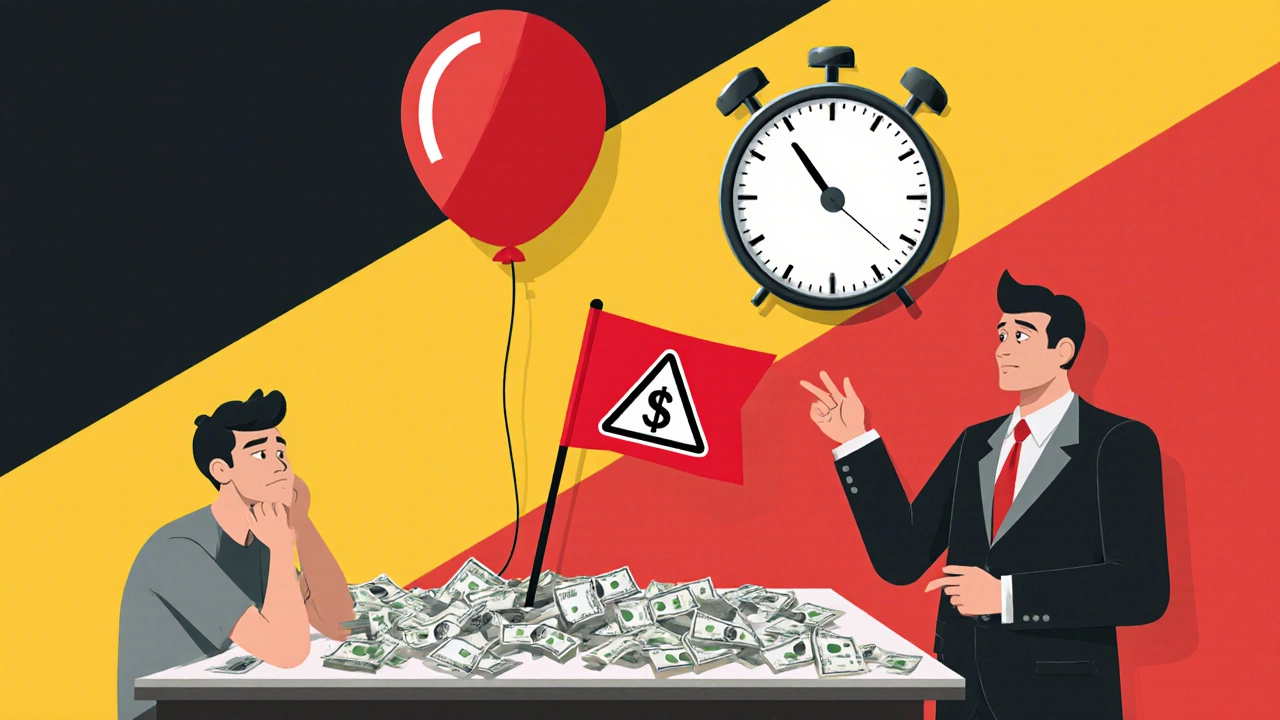Loan Cost Calculator
Loan Details
Toxic Loan Risk Assessment
Loan Risk Assessment
Results
Total Amount Repaid
Total Interest Paid
Total Cost (including fees)
Key Insights
A toxic loan is a high‑cost personal loan that traps borrowers in a cycle of fees, escalating interest and unaffordable repayments. In plain English, it’s the kind of loan that looks tempting at first but ends up draining your wallet and hurting your credit. If you’ve ever wondered why some loans feel like a black hole, keep reading - we’ll break down the mechanics, the warning signs, and the steps you can take to get out of one.
Key Takeaways
- A toxic loan typically carries an APR far above the market average, hidden fees, and repayment terms that are hard to meet.
- Red flags include balloon payments, frequent roll‑overs, and lenders who push you to sign without full disclosure.
- Know your credit score, debt‑to‑income ratio, and the true cost of borrowing before you sign.
- If you’re already stuck, refinancing, negotiating, or contacting a credit‑counseling agency can help.
- Regulators like the US Federal Trade Commission monitor predatory lending practices, but vigilance starts with you.
What Makes a Loan "Toxic"?
Not every expensive loan is toxic. The term usually applies when three core elements line up:
- Excessive cost: APRs often exceed 30 % and can climb higher with daily or weekly compounding.
- Unfair terms: Balloon payments, mandatory early‑repayment penalties, or clauses that let the lender change the rate without notice.
- Borrower vulnerability: Lenders target people with low credit scores, high debt‑to‑income (DTI) ratios, or urgent cash needs.
When these factors combine, the borrower ends up paying more than they borrowed, often for years.
How a Toxic Loan Differs From a Standard Personal Loan
| Feature | Toxic Loan | Standard Personal Loan |
|---|---|---|
| Typical APR | 30 % - 80 % | 5 % - 20 % |
| Fee Transparency | Hidden origination, processing, and late fees | All fees disclosed up front |
| Repayment Structure | Balloon payment or frequent roll‑overs | Fixed monthly payments |
| Credit‑Score Requirement | Often < 600, lender may ignore score | Usually > 650 for best rates |
| Regulatory Oversight | Often sold by unlicensed entities | Licensed banks or credit unions |
Common Tactics Lenders Use
Understanding the tricks helps you spot a toxic loan before you sign:
- Roll‑over traps: When you can’t pay on time, the lender offers a short‑term extension with a new fee, resetting the clock.
- Balloon payments: Low monthly payments that balloon into a huge lump sum due at the end of the term.
- Hidden fees: Origination, paperwork, and “early‑termination” fees that aren’t mentioned until after you’re locked in.
- Variable rates with no caps: The interest can jump dramatically after a teaser period.
- Pressure tactics: Salespeople urge you to sign on the spot, often claiming the offer expires in minutes.

Who Is Most At Risk?
Anyone can fall prey, but certain profiles attract predatory lenders:
- Low credit score: Below 600, making traditional bank loans expensive or unavailable.
- High debt‑to‑income ratio: Above 43 % signals financial strain.
- Urgent cash need: Medical bills, rent arrears, or sudden job loss push people to accept bad terms.
- Lack of financial literacy: Not understanding APR, total cost, or the impact of fees.
Red Flags to Spot a Toxic Loan
Before you hand over a signature, run through this checklist:
- Does the lender hide the APR or present it only after you’ve filled out the application?
- Are there fees that appear only on the fine print (e.g., “processing fee” or “administrative charge”)?
- Is the repayment schedule explained in vague terms, like “payment plan to be determined later”?
- Do they push you to sign immediately, saying the offer will disappear?
- Is the lender not a registered financial institution? Check the US Federal Trade Commission database.
What to Do If You’re Already Stuck
Finding yourself in a toxic loan can feel like you’ve hit a wall, but there are ways out:
- Refinance with a reputable lender: A lower‑interest, fixed‑rate loan can replace the toxic one.
- Negotiate: Some lenders will reduce fees if you demonstrate a genuine intent to pay.
- Contact a credit‑counseling agency: Non‑profit groups can help you build a repayment plan.
- File a complaint: The Consumer Financial Protection Bureau handles predatory‑lending complaints.
- Consider bankruptcy as a last resort: It wipes many unsecured debts but harms credit for up to 10 years.

Regulatory Safeguards
While regulators can’t protect you from every shady lender, they set rules that limit the worst practices:
- The US Federal Trade Commission (FTC) requires clear disclosure of APR and total loan cost.
- The Consumer Financial Protection Bureau (CFPB) caps certain fees and bans loan terms that are “unconscionable.”
- State usury laws often limit how high an interest rate can legally be.
Real‑World Example
Maria, a single mother of two, needed $1,200 to cover a car repair. She found a lender online promising a “quick cash” loan with a 1 % weekly interest rate. The agreement showed a $30 processing fee but omitted a $150 “late‑payment” charge that kicked in if she missed the first payment. Within three months, Maria owed $2,800-more than double the original amount. By contacting a local credit‑counseling agency, she renegotiated the debt, paid off the hidden fees, and later secured a conventional personal loan at 12 % APR to refinance the remainder.
Quick Checklist for Safe Borrowing
- Check the lender’s licensing status.
- Ask for the APR in writing and compare it to market averages.
- Calculate the total cost (principal + all fees) over the life of the loan.
- Read the full contract; don’t rely on verbal promises.
- Never agree to a loan that requires you to roll over payments.
- Confirm there’s no balloon payment due at the end.
- Keep a copy of all communications for future reference.
Frequently Asked Questions
What is the difference between a toxic loan and a predatory loan?
Both terms describe unfair lending, but “toxic loan” usually refers to the loan’s structure (high APR, hidden fees, balloon payments), while “predatory loan” focuses on the lender’s intent to exploit vulnerable borrowers.
How can I tell the true APR of a loan?
The true APR includes interest plus all fees spread over the loan term. Ask the lender for a “Truth‑in‑Lending” statement that lists every charge, then use an online APR calculator to verify.
Are there any legal limits on how high interest can be?
Yes. Most states have usury laws that cap interest rates, and the FTC requires lenders to disclose APR clearly. If a rate exceeds the legal limit, the loan may be voidable.
Can I refinance a toxic loan with a credit‑union loan?
Often yes. Credit unions typically offer lower APRs and transparent terms. The key is to apply before the toxic loan’s balloon payment is due, then use the new loan to pay off the old one.
What should I do if I suspect fraud?
File a complaint with the FTC or CFPB, and report the lender to your state’s banking regulator. Keep all documentation; it helps investigators track the scam.
Is a toxic loan always illegal?
Not always. Some high‑cost loans are legal if fully disclosed and within state usury limits. The problem arises when fees are hidden or terms are misleading, which can be illegal under consumer‑protection laws.

